NFL draft: Yahoo Sports' top 2019 prospects, Nos. 51-60
Leading up to the 2019 NFL draft, which starts April 25, Yahoo Sports will count down our top 100 overall prospects. We’ll count them down 10 at a time, followed by profiles on our top 30 overall players.
Previous entries: 100-91 | 90-81 | 80-71 | 70-61
60. Louisiana Tech EDGE Jaylon Ferguson
6-foot-5, 271 pounds
The lowdown: A Butkus Award semifinalist, Ferguson broke the all-time NCAA sacks record of 44 (held by Terrell Suggs) when he took down Hawaii’s Chevan Cordeiro (one of Ferguson’s 2.5 sacks that day) in the Hawaii Bowl which was Ferguson’s final college game. He totaled 17.5 sacks on the season (most in the country) and finished his brilliant four-year career with 67.5 tackles for loss and seven forced fumbles.
Ferguson had a solid week at the Senior Bowl, but he was not allowed to attend the NFL scouting combine because of the league's policy of not inviting players with “a conviction of a felony or misdemeanor involving violence." As a freshman at Louisiana Tech, Ferguson was convicted of simple battery following a fight at a McDonald's, and he also had a public intoxication charge while in college. NFL teams don’t appear to view him roundly as a character red-flag candidate, but his checkered past has forced teams to do more digging on his background.

All 32 teams attended Ferguson’s pro day workout, where he reportedly turned in some disappointing workout numbers – especially in his 10-yard split, vertical jump, 20-yard shuttle and 3-cone drills. Those last two times were very concerning, suggesting a lack of short-area quickness. He played last season closer to 260 pounds, we’re told, so it’s possible that the weight he added wasn’t “good weight” and Ferguson might need to slim down to be more effective in the pros.
DE Jaylon Ferguson Pro Day results (from an NFL exec):
6046, 271
40: 4.82, 4.83
10: 1.69, 1.70
Bench: 24
VJ: 32
BJ: 9-9
SS: 5.12
3C: 8.08— Dane Brugler (@dpbrugler) March 20, 2019
The tape shows a player who will work to get pressure after his initial moves are stymied, such as this sack against Mississippi State. Ferguson plays with active, violent hands and will vary his pass-rush arsenal quite a bit. But he displays some underachiever traits, isn’t a top-tier run defender and must maintain better gap integrity instead of sack hunting every snap.
A bit of an older prospect, Ferguson will turn 24 near the end of his rookie season in the NFL.
Fun fact: Ferguson earned quite the fitting nickname: “Sack Daddy.” And it turns out he might have given himself the nickname following a big game early in his career after hearing someone call his teammate “Mack Daddy.”
Draft range: Round 2
59. Washington OT Kaleb McGary
6-foot-7, 317 pounds
The lowdown: One of the tallest prospects in this year’s class, McGary also curiously has remarkably short arms (32 7/8 inches) that might come in just below some teams’ ideal length for an NFL tackle. Of course, many successful NFL tackles have gotten by with arms shorter than that – Joe Thomas comes immediately to mind – and McGary’s toughness, surprisingly athletic build and strong base could make him a Day 1 starter as a right tackle. Some NFL teams also have discussed making him a guard, which could maximize his run-blocking potential.
Issues with curtailing speed come from McGary’s lack of ideal lateral quickness (his combine testing belies this a bit) and his tendency to rise in his stance, which is a problem with a lot of taller blockers. He also fails to shoot his hands at times and can let his feet stop moving on lateral blocks. Here’s an example of McGary allowing a wide-9 rusher (Auburn’s Nick Coe) to long-arm rush him, gain leverage and nearly get a sack in 2.5 seconds on a screen play (30-second mark):
McGary might not be the prettiest, most textbook blocker in this year’s good crop of OL talent. But he maintains a nasty on-field demeanor, is experienced (47 career starts at right tackle) and has the strength to be an early starter – and perhaps a higher pick than some anticipate. You can bet that offensive line coaches will favor his intangibles and pound the table for McGary, believing they can work out his technical kinks over time.
Although McGary wasn’t medically flagged for his heart (see below), he passed out during a high school basketball game in 2013, leaving a permanent scar on his nose, and he later was diagnosed with arrhythmia. Since then, he has had three different heart procedures that reportedly have improved his condition.
Fun fact: There’s actually nothing fun about the adversity McGary and his family have been through in recent years. In addition to his heart arrhythmia, his father was diagnosed with multiple sclerosis, the family dog died and the family has had to move around because of some bad luck. They were forced off their farm while nearing bankruptcy and later saw McGary’s mother’s childhood home burn down (along with one of the family RVs) in January 2018 while they were attempting to restore it.
Asked about his travails at the combine, McGary attempted to diffuse it with humor. “So fair warning: It's basically a country song, so get ready,” he said. But he also spoke of how the humbling and haunting series of events shaped him as a man.
“It kind of lends to that perspective that I took away from all of this,” he said. “Shows me, wow, how easily I could not have any of this. Being technically homeless for two years will make you see things a little differently. It's given me a tremendous amount of appreciation and excitement, really. It's almost hard to believe that [trying to make the NFL] is a dream I've had since the fourth grade. As my life has gone on, all I've gained is more motivation, more drive, more reasons to continue and push on.
“And now finally knocking on the door of that dream, it's kind of a weird feeling, but it's really cool.”
Draft range: Top 50 selection, and don’t be shocked if he sneaks into the back end of Round 1
58. Boston College EDGE Zach Allen
6-foot-4, 281 pounds
The lowdown: Allen is a high-effort, power-based rusher who outworks his opponents to get his production. And the numbers are off the charts: 40.5 tackles for loss over his past three seasons, a 100-tackle season in 2017 (almost unheard of for a defensive lineman) and 14 passes defended. His sack totals (six, four and 6.5) have been modest. But Allen has shown a nose for the football with two interceptions, four fumble recoveries and two blocked kicks (one extra point, one field goal) as a senior.
Most of his big plays come on hustle. He’s not at all an edge bender, and that became clear early in the one-on-one drills at the Senior Bowl practices. Allen doesn’t possess the quickness or flexibility to speed rush people in the NFL, but there absolutely is a home in the league – likely as a starter – with his tone-setting energy, great awareness and elite hand-fighting skills.
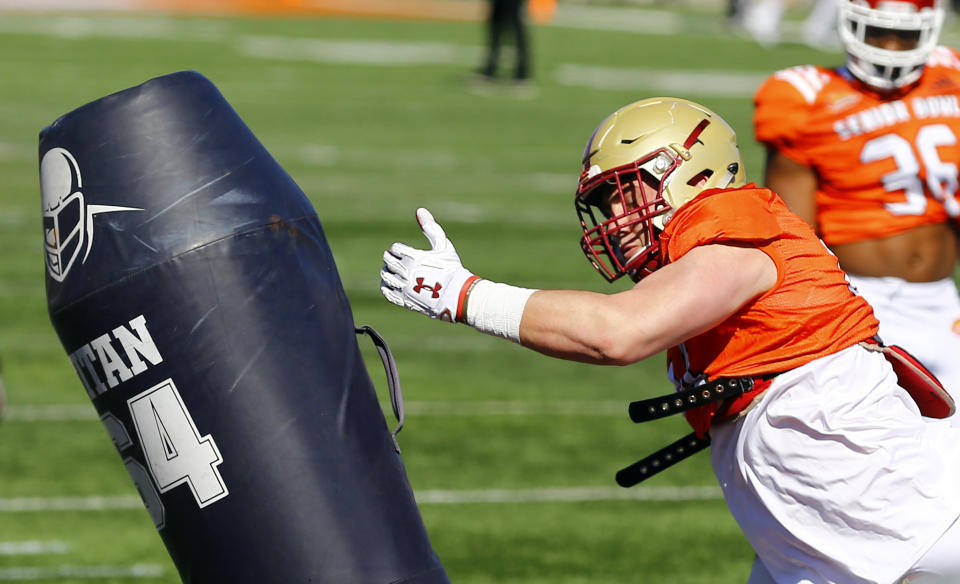
At worst, Allen projects as a very good run stopper and strong rotational player. He actually has underrated quickness off the snap and can be effective lining up in the A, B and C gaps depending on the down and distance. It’s hard not to watch Allen’s motor on tape and like his potential, even if his athletic limitations cannot be ignored.
Fun fact: Allen was a standout in baseball, basketball and football as a kid, and as a freshman in high school he decided that he needed to drop one of the three sports in order to get better at the other two and still try to get straight A’s in school. The sport he initially dropped? Football. Allen dreamed of being the next Alex Rodriguez or Derek Jeter then, but his high school coach called Allen’s father – with Allen in his office – and explained how poor a decision that was. Allen stuck with football, played varsity as a freshman outside linebacker and the rest is history.
Draft range: Round 2 to 3
57. Vanderbilt CB Joejuan Williams
6-foot-3, 211 pounds
The lowdown: Big, long-levered corner who is pushing the upper limits, height-wise, of what you typically see at the position. That’s a major positive for a press-man team seeking to take Williams’ unrefined skills and cultivate it properly. But the lack of polished skills and deficiencies in off and zone coverage make him a tricky evaluation. His scouting combine 40-yard dashes in the high 4.6-second range also complicate matters, even if he improved on them (4.55) at his pro day.
Williams didn’t intercept a pass until this past season as a junior, but he snagged four interceptions and batted away 14 more passes. It’s easy to see his aggression and competitiveness on tape, and that along with the physical skills are likely to make him appealing to teams running certain schemes. Williams left school after his junior season and likely could have used another year in college, even though he’ll turn 23 at the end of his rookie season.
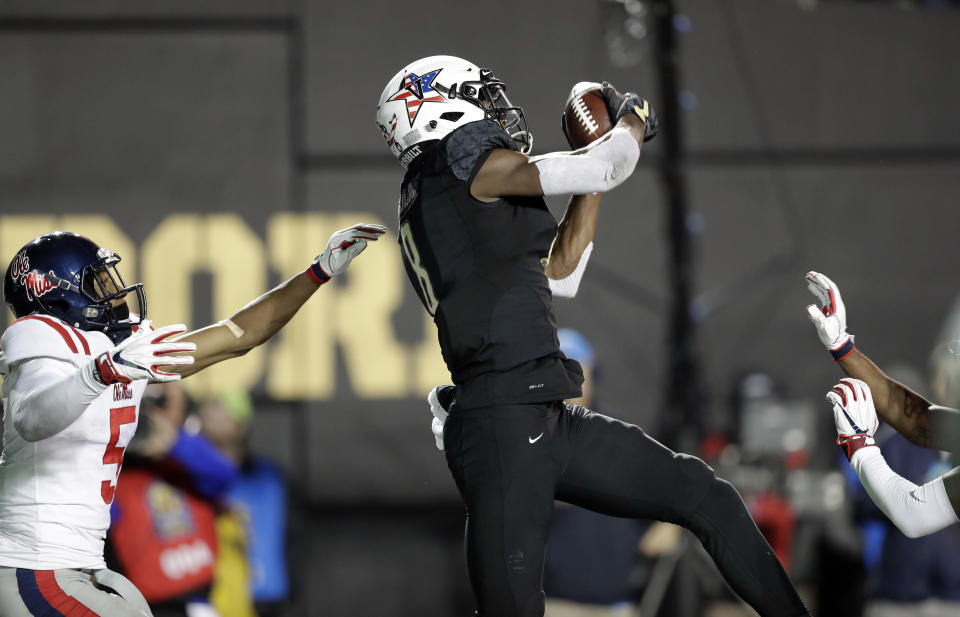
Facing top competition in the SEC, along with a high-profile non-conference matchup against Notre Dame (Miles Boykin), Williams has some terrific tape going against quality receivers. But even in these games, there’s a little good and bad in each of them. Against Ole Miss, Williams played a terrific game for most of the contest against A.J. Brown and DaMarkus Lodge, but also surrendered back-shoulder catches to each, displaying how Williams sometimes struggles to locate the ball. And against Georgia, after a few nice early reps, Williams was undone by the quickness of the Bulldogs’ receivers.
With the right development, Williams could be an elite press corner. But if his shortcomings never improve, it’s easy to see his bust potential in the NFL.
Fun fact: A self-described candy connoisseur, Williams has tried to cut out the sugar from his diet and eat more vegetables – even the much-maligned cauliflower.
“Cauliflower is the worst. I hate it. It’s so bad,” Williams told the Tennessean. “But I have to be attuned to what my body needs. You can’t put regular gas in a Lamborghini.”
His favorite candies: Skittles, Mike & Ike and Starburst. And his solution for making the veg more palatable? “I started putting teriyaki over all my vegetables to get them down,” he said.
Draft range: Round 2 to 3
56. Duke QB Daniel Jones
6-foot-5, 221 pounds
The lowdown: Jones is a three-year starter whose mechanics, toughness and athleticism have drawn praise in NFL circles. Throwing to a less-than-impressive crop of pass-catchers and working behind shaky offensive lines, Jones put up strong enough numbers, even with a shocking number of dropped passes that dropped his completion percentage just a tick below the 60 percent mark (59.9) for his career. In 2018, despite missing two games, Jones completed 60.5 percent with a 22-9 TD-INT ratio.
Jones missed those two games (against North Carolina Central and Baylor) after he suffered a broken collarbone against Northwestern. He stunned observers by coming back three weeks later in a start against Virginia Tech, which ended up being one of his better individual games of the season, even if his stats were modest and the Blue Devils lost. Following a 423-yard, six-TD performance in the Independence Bowl, the fourth-year junior declared for the draft.
Groomed by former Peyton and Eli Manning whisperer, David Cutcliffe, Jones has good footwork, a tidy throwing motion and displays the ability to go through progressions (even to his third read) and operate amid pressure. Jones is a very smart and effective short and intermediate passer, and he’s a surgeon in the red zone with good placement and timing throws. And for defenses that fail to respect his athleticism, he has surprisingly good scrambling ability (check out the North Carolina game).
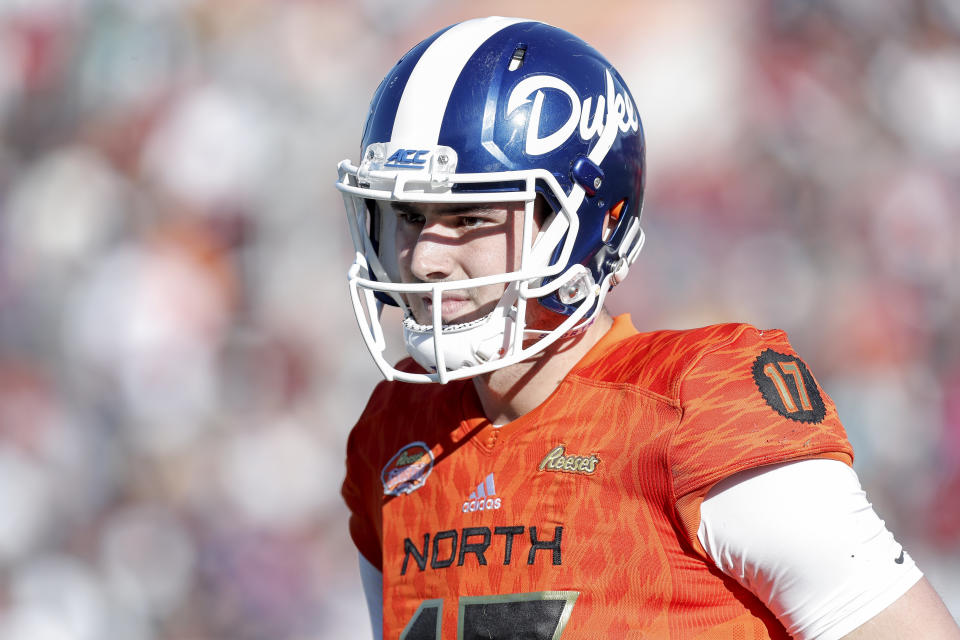
Still, he must speed up his clock against the blitz and develop his downfield timing and accuracy. Jones lacks a great arm, needing to rely more on touch and placement on passes 20-plus yards down the field, so it goes back to speeding up his process in a faster-moving NFL game. Practicing alongside Missouri’s Drew Lock all week, Jones appeared to be the lesser of the two prospects while running Jon Gruden’s offense for the North Team. However, Jones upstaged Lock in the game itself, earning Offensive MVP honors with a strong outing.
Jones’ composure and mechanical refinement make him a high-floor template as a prospect, and he likely wouldn’t embarrass himself if thrust into the lineup early in his career. There are enough limitations in his game to ever imagine him becoming great.
It’s not just because of the Cutcliffe connection, but there are some Eli Manning-esque elements to Jones’ game, albeit with far better athletic traits and a lesser arm. Like Manning, Jones cut his teeth while leading (and raising) a college offense largely bereft of NFL-caliber talent. That’s where some NFL evaluators believe there might be untapped potential and a better outlook than other scouts have cast on him. Do those who like Jones like him because of the Cutcliffe connection? The draft grades on Jones are all over the board.
Fun fact: Jones initially committed to Princeton, with a broken wrist suffered during basketball season hurting his football recruiting. But once Jones’ QB coach, David Morris, put in a call to Cutcliffe at Duke, Jones flipped his allegiance. It didn’t hurt that Morris once played for Cutcliffe at Ole Miss … where he was Eli Manning’s backup. (via MMQB)
Draft range: Top-50 pick, perhaps as high as the middle of Round 1
55. Ohio State DL Dre'Mont Jones
6-foot-3, 281 pounds
The lowdown: Jones is one of the most athletic, long-armed interior rushers in this class, able to shoot through gaps and make plays behind the line of scrimmage. Prior to the 2018 season, his athletic traits and upside outweighed his production, but he was named first-team all-Big Ten with a strong junior year (13 tackles for loss, 8.5 sacks, three fumble recoveries and one interception) before declaring for the draft.
His combine performance disappointed as he failed to turn in any eye-popping work in any athletic drill. But Jones’ quickness is evident on tape, and dealing with him for four quarters must have been a chore for many slower-footed guards. You almost think Jones lined up in the neutral zone several times the way he can pop off the snap and get skinny to knife through cracks in the blocking. He’s also very creative with his movement. Check out this play against Washington in the Rose Bowl, where Jones fakes like he’s going to stunt or loop to another gap, gets the guard to lunge and darts into the backfield for a tackle for loss.
Watching his overall skills, it appears Jones might be relegated to a one-gap system – likely as a 3-technique. Teams that seek more bulk and technique-versatility in their defensive linemen might end up putting a lower grade on Jones, and his lack of power in the run game is concerning. Teams sometimes had success combo blocking Jones and running through his gap (see TCU, Minnesota games). He also can get too upright and make himself susceptible to cut blocks.
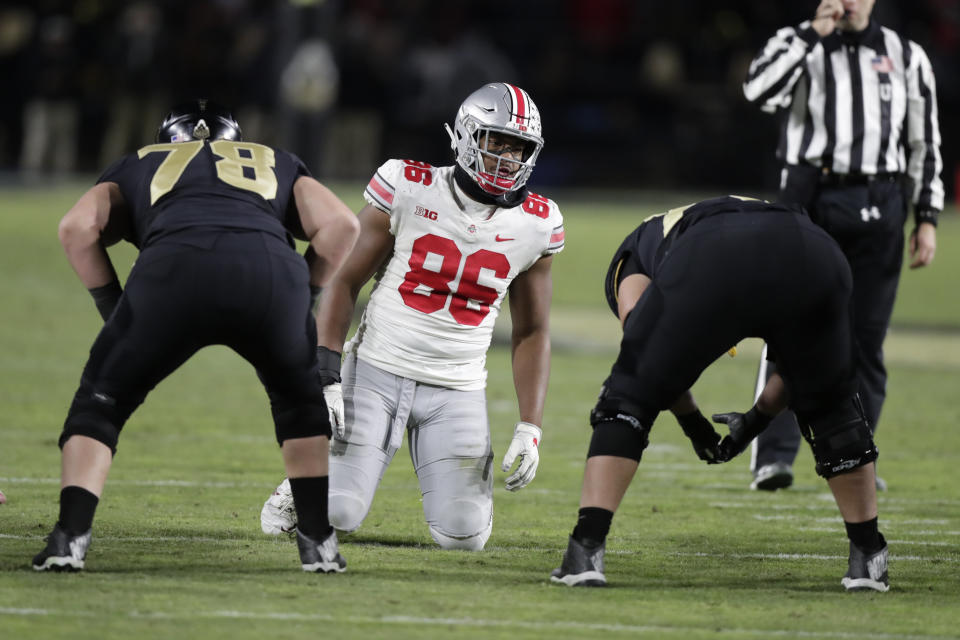
Fun fact: Jones might have had the most interesting summer job among this year’s draft class. Last summer, he interned with the DEA – yeah, the Drug Enforcement Agency. The Buckeyes have a weekly team-sponsored segment called “Real Life Wednesdays” and one of the presentations was from head coach Ryan Day’s brother, a DEA agent, in 2017. Jones inquired about spending an internship with the agency, he was accepted and sent to Manchester, New Hampshire, for a week.
Asked what he did during the week, Jones showed he has the makings of a future agent.
“Can’t tell you,” he said with a smile at the combine. “It’s confidential.”
Draft range: Round 2 or 3
54. Alabama S Deionte Thompson
6-foot-1, 195 pounds
The lowdown: Thompson emerged early last season as an eye-opening playmaker in a Bama secondary that has churned out NFL talent over the past several years, carrying over the impressive performances he turned in against Clemson and Georgia in the college football playoffs as an injury replacement for Hootie Jones. By the end of the 2018 season, however, Thompson’s evaluation clouded quite a bit, although he felt comfortable enough with his grade from the NFL underclassman advisory committee because he declared following his redshirt junior season despite starting full time for only one year.
#NFL draft notes thread...
1. Evaluators are anxious to see #Alabama safety Deionte Thompson at today's pro day. There were concerns about his weight coming out of the combine (195 vs. 180ish in season). His speed/weight has left his overall report up in limbo for some teams.— Charles Robinson (@CharlesRobinson) March 19, 2019
Thompson was named first-team All-American and first-team All-SEC in 2018, with 79 tackles, 3.5 tackles for loss, two interceptions, six pass breakups and four forced fumbles in 15 games. He’s a lean-built playmaker and risk taker, and there are enough highs in his 2018 performance to suggest he could be a very good single-high safety in time. Thompson is aggressive, possesses ball skills and a physical element to his game that routinely shows up.
#Alabama S Deionte Thompson — Teaching point here when rotating to the post. No need to square back up & pedal. Stay open + read the QB. He will take you to the ball. @NFLMatchup pic.twitter.com/WvQs6WtMOC
— Matt Bowen (@MattBowen41) February 25, 2019
His two games in the college football playoffs showed a gambler who sometimes takes the cheese from talented deep-ball throwers and eye-manipulators. Both Oklahoma’s Kyler Murray in the semifinal and Clemson’s Trevor Lawrence found ways to use Thompson’s aggressiveness against him, leading Thompson to make some poor decisions and lose coverage. He also carries durability concerns with his thin lower body and sometimes reckless style crashing down into traffic.
With the right coaching and patience, Thompson should develop into an instinctive playmaker in the mold of former Jacksonville Jaguars first-rounder Reggie Nelson or Tampa Bay Buccaneers second-rounder Justin Evans.
Thompson always will be around the ball, but his overall game needs refinement.
Fun fact: Deionte attended the same high school as his mother, Pamela, who was a star preps basketball player. She later played hoops and ran track at Wiley College in Texas, and Deionte said last year that she remains the best athlete in the family, even though his father also played baseball at Wiley.
“I had to live up to her standards,” he told The Athletic in September. “So that’s kind of what drove me through high school to always live up to her and try to get to state in just about every sport that I did because that’s exactly what she did.”
Draft range: Round 2
53. Iowa S Amani Hooker
5-foot-11, 210 pounds
The lowdown: Hooker was named Defensive Back of the Year in the Big Ten, although his position – the “star” spot the Iowa coaches created for him before last season – was a hybrid of safety and linebacker, and he often covered the slot as well. In 13 starts last season, Hooker earned the Hawkeyes’ defensive MVP award by tying for the team lead in interceptions (four) and pass breakups (seven), and ranking second in tackles (65). Hooker declared for the 2019 NFL draft and won’t turn 21 until June.
He’s an instinctive playmaker who can play a few roles, similar to the Patriots’ Patrick Chung in some ways, even if Hooker might never be a great man-coverage piece or a lights-out enforcer. His high level of anticipation and pattern recognition is rare for such a young player, and his technique is good even to Iowa standards. This program has churned out some underrated NFL talent the past several years, especially among DBs, and Hooker appears to be the next in line.
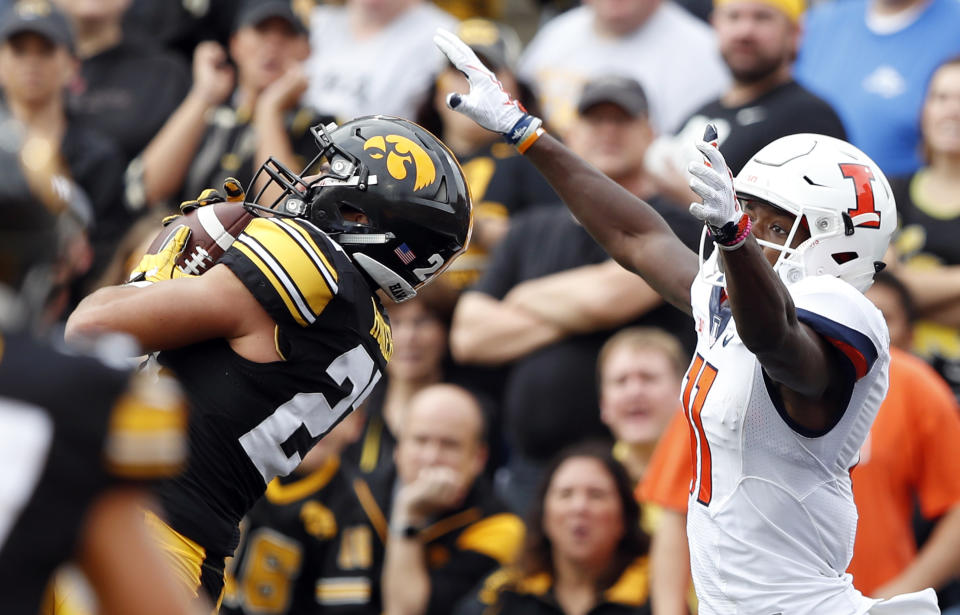
Hooker tested well at the NFL scouting combine, although some evaluators believe he doesn’t quite match those numbers on the field and could be tested when being asked to cover receivers, backs and tight ends with elite size or speed. But he has a three-down makeup for a defense that doesn’t mind bringing a smaller defender close to the box, where his best work appears to be done. He also profiles as a core special teamer, performing well in that role as a freshman.
Fun fact: Hooker was a finalist for Minnesota’s Mr. Football Award in 2015 and a three-time all-state selection as a quarterback, running back and cornerback in high school. Growing up in Minneapolis, it was his dream to attend the University of Minnesota, even going to three separate camps there with the hopes of catching the eyes of the Gophers coaching staff. But his only Power-5 offer was from the Hawkeyes, so he pledged to Iowa. In three games vs. the Gophers during Hooker’s time in school, the Hawkeyes won all three and he had a terrific game with two pass breakups.
Draft range: Round 2 to 3
52. Georgia EDGE D'Andre Walker
6-foot-2, 251 pounds
The lowdown: An ascending talent who bided his time behind 2018 third-rounder Lorenzo Carter, Walker didn’t start until his senior season but made tangible strides each year. He appears to have the look of a player who will be better in the NFL than he was in college.
Walker led the Bulldogs in tackles for loss (11), sacks (7.5) and QB pressures, according to the coaching staff, with 14.
He might be a shade undersized to be a full-time end, but he easily could stand up and rush the passer in the NFL. He has the burst, balance and flexibility to get into the backfield, and his high-energy approach will make him a more attractive prospect. Playing with a stronger base and better technique against the run will be critical to his evaluation for one-gap teams to see if he can play on the line full-time. His work in space on his feet remains unkempt, but good coaching and additional reps should help him develop in that area.
Walker can rush from both sides and is effective on line stunts, closing fast and taking the shortest path to the ball. He turned in a disruptive performance in the SEC title game against Alabama, even shocking possible top-10 pick Jonah Williams a few times with pressures. Walker suffered a groin injury in the fourth quarter of that game, also missing the Sugar Bowl and the Senior Bowl while rehabbing the injury.
He’s not nearly the player Khalil Mack was coming out of Buffalo, but Walker exhibits some of the same traits and energy in his game. Walker even uses Mack’s long-arm pass-rush move with great effectiveness, leveraging blockers in the direction he wants to send them. There’s a lot to like about his game, but he also remains a raw player whose best work might be a few years down the road.
Fun fact: Walker is respected by his teammates and Georgia’s coaches for his work ethic, but he also deserves praise for his candor. Asked about the Bulldogs’ poor effort in the bowl game against Texas without him on the field, with the team perhaps upset it was left out of the college football playoffs, Walker didn’t hold back. “I don’t think they were giving maximum effort in that game,” he said. “I feel like they felt like they didn’t have anything to play for. We thought we were going to be in the playoffs, but we didn’t. I feel like they didn’t take the game very seriously. And then … me not being out there, that was another big thing. Deandre Baker wasn’t out there as well. Everybody’s mindset had pretty much altered, and it was getting ready for the next year.”
Draft range: Round 2
51. Alabama LB Mack Wilson
6-foot-1, 240 pounds
The lowdown: Lyndell “Mack” Wilson was expected to be the latest in line of the great Alabama linebacker tradition, flashing some of the traits of his forefathers down the stretch, but his overall performance last season didn’t push Wilson into that same level. The former five-star recruit stepped onto the field as a true freshman, making a big impact on special teams, before he ascended to a starting role and was one of the best players on the field in the 2017 national title game victory over Georgia (12 tackles, two for loss). Wilson earned second-team all-SEC in 2018 with some dominant stretches and fits the mold of the new-wave NFL linebacker who can impact the run and pass equally, but he tended to freelance too much and missed some plays while trying to deliver highlights.
There still is a lot to like in his game. He can pursue well, run and hit, and anticipate well in the passing game. Wilson has the size and movement NFL teams are seeking for a middle linebacker, and the versatility will be very appealing for the pro game. But there are times he guesses wrong and finds himself out of position, and Wilson had too many missed tackles.
Teams interviewing Wilson at the NFL scouting combine also came away with less-than-ideal impressions, with one team calling him “a different bird” and another scout adding, “I didn’t talk to him personally, but two of our guys said their interactions with him were a bit bizarre.” At the combine, Wilson did only the jumping drills and he opted out of the rest because of a sore hamstring – an injury that some teams questioned the severity of. At Wilson’s pro day, he ran 40-yard dash times of 4.71 and 4.65, and later said, “I didn’t have a perfect pro day.”
Fun fact: Alabama head coach Nick Saban issued a challenge to Wilson at the SEC Media Days when he said, “We need Mack to really be the guy on defense for us this year when it comes to the leadership and how he affects other people.”
Whether he did that remains a judgment call. Wilson admitted a day later that his on-field work had been delayed in absorbing the Tide’s complex defensive system.
“It took me about a year and a half to learn our playbook,” Wilson said.
Draft range: Round 2
More from Yahoo Sports:

